| 
Introduction
'Dragon Search' is a national monitoring program which
encourages members of the community to provide information
about sightings of the unique southern Australian fish
- the seadragon. The information has been used to greatly
increase our understanding of the distribution, habitat
requirements and research and management priorities
for these little-known species. Anyone who visits the
beach in Australia has been able to get involved.
Although Dragon Search is no longer funded, many aspects
of this program have been incorporated into the South
Australian Reef Watch Feral
or In Peril program. In particular, reports
of sea dragon sightings can still be made. The data
will be stored in the Reef Watch database. In the future,
the data can be extracted separately for each state
to produce periodic Dragon
Search reports.
Other information that has been retained from the original
Dragon Search website includes the Code
of Conduct, archive of newsletters
and media releases, and the photo
library and video
footage.
Dragon Search
has been supported throughout Australia by the following
organisations











Further information can be found
under the headings below:
Syngnathids
Weedy
(Common) Seadragons
Leafy
Seadragons
Seaweed
Swayers
Male
Mothers, Wrinkly Tails and Egg Cups
'Take
Two Seahorses and Go To Bed...?'
Why
Survey for Seadragons?
You
Could be a Pioneering Scientist!
How
To Get Involved!
What
Are We Doing?
What
Are the Principal Aims of Dragon Search?
That
Face Looks Familiar
The
Database
I
Don't Dive or Snorkel, But Want To Help...
References
Syngnathids
Seadragons are found only in southern
Australian waters. Along with seahorses, pipehorses
and pipefish these spectacular fish belong to the Family
Syngnathidae. Syngnathids are long, slender fish with
bony plates surrounding their bodies. The Latin name
'syngnathid' refers to their jaws, which are united
into a 'tube-snouted' mouth.
The two species of seadragons, the Leafy
Seadragon (Phycodurus eques) and the 'Common'
or Weedy Seadragon (Phyllopteryx taeniolatus),
both have many leaf-like appendages on their heads and
bodies. The resemblance of seadragons to seahorses is
superficial as the two seadragon species are more closely
related to the pipehorses (Gomon et al. 1994).
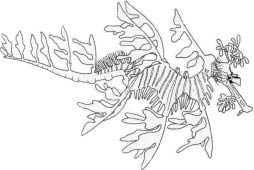 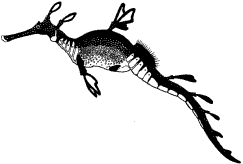
Leafy Seadragon (Phycodurus eques)
Weedy Seadragon (Phyllopteryx taeniolatus)
Graphic by Sue Stranger (Untamed
Art)
Graphic by Sue Stranger (Untamed Art)
Back to contents
Weedy (common)
seadragons
'Weedies' grow to about 46 cm in length.
Adults are usually reddish with yellow spots and purple-blue
bars. Small leaf-like appendages occur singularly or
in pairs along the body. A few short spines also occur
along the body. It is quite easy to determine the gender
of a weedy seadragon. A male weedy has a shallow body
width and is generally darker in colour than the female.
Weedies have been recorded from Geraldton in Western
Australia along the southern Australian coastline -
including Tasmania - to Port Stephens in New South Wales.
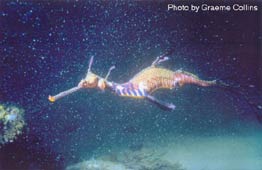
A male weedy seadragon. Photo by Graeme
Collins.
Back to contents
Leafy seadragons
‘Leafies’ are slightly smaller than weedies,
some growing to 43cm, however most reach an average
of 30cm. Their leafy appendages are more numerous and
branching than on weedies and look distinctly like fronds
of brown seaweed. Adults are green to yellow-brown with
thin, pale dark-edged bands. As with many species of
seahorse, seadragons are able to change colour depending
on age, diet, location or even their stress level. Unlike
weedies, the leafy seadragons' eyes are located slightly
above the snout. Leafies have several long sharp spines
along the sides of the body. These spines are thought
to be used as a defence against attacking fish. New
research has shown that leafy seadragons have a highly
sophisticated navigation system, venturing hundreds
of metres from their base but returning precisely to
the same spot (Connolly 1998). The leafy seadragon has
a much smaller range than the weedy. Leafies have been
recorded from Geraldton in Western Australia along the
southern Australian coastline to Wilsons Promontory
in Victoria.
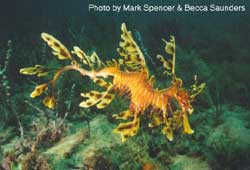
Leafy seadragon, Fleurieu Peninsula
(South Australia). Photo by Mark Spencer & Becca
Saunders.
Back to contents
Seaweed
swayers
Seadragons resemble swaying seaweed,
which can make them difficult to find in their natural
habitats. They are slow moving and therefore rely heavily
on camouflage for their survival. Their bright colours
are revealed in sun dappled waters or under bright camera
lights. Both species of seadragon inhabit rocky reefs,
seaweed beds, seagrass meadows and structures colonised
by seaweed. In the wild they live individually or in
pairs are more often seen in shallow coastal waters.
They feed by sucking plankton, larval fishes and small
shrimp-like crustaceans, called mysids, into their small
mouths. This is done by quickly expanding a joint on
the lower part of their snout, causing a suction force
that draws the food in (Groves 1998).
Back to contents
Male mothers,
wrinkly tails and egg cups
As spring approaches, male and female
seadragons pair. The female develops around 300 orange
eggs in her lower abdominal cavity. The lower half of
the tail on the male begins to form fine blood vessels
near the surface, swells and looks wrinkled. He then
develops about 120 small pits or 'egg cups' on the tail
and the eggs are transferred from the female and fertilised.
Although this transfer has yet to be observed, we suspect
it occurs in the dark, pre-dawn hours. Dragon Searchers
in Tasmaina are using infra-red video equipment to try
and observe the egg transfer and other breeding behaviour
of weedy seadragons.
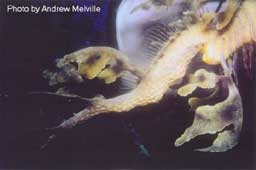
The male's tail swells and looks wrinkly
as the 'egg cups' develop before egg transfer. Photo
by Andrew Melville.
The male carries the eggs for an incubation
period of about 4 weeks. The young seadragons hatch
over several days. This staggered hatching is to aid
dispersal and avoid competition for food amongst the
young. At birth, seadragons are around 20mm long and
are often differently coloured to the adults. The young
are preyed upon by fish, crustaceans and sea anemones
and live in different places to the adult seadragons.
The young dragons are fast growing, reaching 20cm after
one year and a mature length after about two years.
It is not known how long wild seadragons live. In captivity
it is thought that they can live for about 5 to 7 years.
Seadragons, along with all other fish, have ear bones
(otoliths) that show growth rings. New growth rings
are continuously produced throughout the seadragon's
life. One of the reasons dead beach-washed wild seadragons
are very important is that it may be possible to age
the beach-washed seadragons from these growth rings,
therefore giving us a better understanding of the age
of seadragons in the wild. The general health of the
seadragon throughout its life and its changing growth
rates can also be determined from the otoliths.
Back to contents
'Take two
seahorses and go to bed'
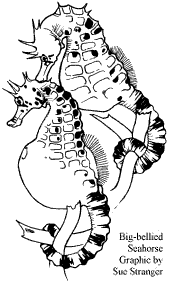 There
is increasing concern about the future of seadragons
and other syngnathids in Australian waters. Seahorses,
seadragons, and in particular, pipefish, are threatened
globally by habitat destruction. An estimated 20 million
seahorses (but not seadragons) are taken each year for
traditional Asian medicines. The international trade
in seahorses and pipefish involves more than 20 countries
and is growing. There
is increasing concern about the future of seadragons
and other syngnathids in Australian waters. Seahorses,
seadragons, and in particular, pipefish, are threatened
globally by habitat destruction. An estimated 20 million
seahorses (but not seadragons) are taken each year for
traditional Asian medicines. The international trade
in seahorses and pipefish involves more than 20 countries
and is growing.
Fortunately seadragons currently are
not used for the medicine trade, however they may be
targeted in the aquarium fish trade. Keeping live seadragons
is extremely difficult and collectors often target males
with eggs, hatching out and selling the young. Removing
these brooding animals from the wild populations may
impact on local populations of seadragons. To date,
no successful, closed cycle, captive-breeding program
has occurred (ie getting a generation of captive-raised
seadragons to breed). Economically and environmentally,
it makes sense to limit collection and export of this
species until we know more about them. Seadragons have
a specific level of protection under fisheries legislation
federally and in most Australian states where they occur,
such that it is illegal to take or export them without
a permit.
Back to contents
Why survey
for seadragons?
It is only recently that the threats
to marine biodiversity have been recognised. These threats
relate indirectly or directly to development of coastal
areas and pollution or exploitation by humans. There
are numerous examples of marine mammals and birds that
have become extinct or are threatened but little is
known about the vast majority of marine invertebrates
and fish (Jones and Kaly 1995), or their status.
Many people think of fish in the ocean
as an inexhaustible resource. Most of the research on
fish in Australia is on commercial species and little
is known of the lives of even the most common non-commercial
species. Divers who know their local areas and favourite
dive spots can often see changes but are often a quiet
minority. By making divers familiar with recording observations,
the seadragon monitoring program aims to encourage divers
to be pioneering researchers, since virtually nothing
is known about many marine creatures, in the wild or
captivity.
Most people are familiar with the "charismatic
marine mega-vertebrates", marine mammals such as whales,
dolphins or sea-lions. In southern Australia marine
protected areas for threatened species relate to sea-lions
and more recently in South Australia proposals of habitat
protection for Southern Right Whales. There are however
a number of fish and invertebrate species and their
habitats that may be threatened, but there is little
information available to assess their status or define
areas for habitat protection.
There are usually limited resources for
fisheries managers to investigate the conservation and
management of fish that are not directly targeted by
'traditional' recreational or commercial fishing. With
this in mind the Marine and Coastal Community Network
(SA), the Threatened Species Network (SA) and the Marine
Life Society of South Australia undertook to develop
a database of leafy and weedy seadragon sightings. Seadragons
are potentially a "flagship species" for marine conservation
in southern waters. They are popular species that can
serve as a rallying point for major conservation initiatives
(Noss, 1990).
Fish such as the seadragon highlight
the high degree of uniqueness or endemism of species
that exists in southern temperate waters. For example,
as well as the many unique fish and invertebrates, there
are twice as many species of seaweeds alone in southern
waters than on the Great Barrier Reef and off Ningaloo
Reef in Western Australia. Australians are not generally
aware of the immense marine biodiversity they have off
their southern coast and the spectacular and unique
environments that exist there.
Water-watch, Frogwatch and Environmental
Protection Authority programs use frogs as a "charismatic"
and useful indicator of freshwater water quality monitoring.
Seadragons are colourful marine fish that could be adopted
in a similar "mascot" capacity for marine water quality
awareness. It has been suggested that seadragons may
be sensitive to changes in water quality. Long-term
monitoring of seadragon populations could also be useful
as indicators of changes in water quality, especially
in relation to catchment events.
There is widespread interest in developing
community processes for the monitoring of salt-water
environments, including mangroves, estuaries and sea
grass. The Marine and Coastal Community Network hopes
to encourage a adoption of similar community initiatives.
Awareness generated by the Dragon Search project has
been beneficial in generating interest in other marine
monitoring projects such as Reefwatch, a community reef
monitoring program.
A basic principle of the project is the
assumption that learning about the marine environment
and sharing your knowledge and enthusiasm is the one
of the best ways to help make a difference. Seadragons
are animals which stir up emotion and have encouraged
a lot of curiosity in divers, beachcombers, teachers
and students. By reducing marine pollution and conserving
the marine environment for species such as seadragons
we can also ensure a healthy environment for all our
marine life.
Increased awareness and involvement of
local communities may help prevent poaching of seadragons
and encourage protection of both the species and its
habitat. Responses to the project have already reflected
this, with people from around the country contacting
the project coordinators to express concern over potential
threats. The ultimate aim of the project is to provide
information to identify sites suitable for Marine Protected
Areas for the species and habitat and to create an atmosphere
of responsibility and ownership in the community towards
these areas.
Back to contents
You could
be a pioneering scientist
Some of the life history of seadragons
is known from observing captive and, to a lesser extent,
wild animals. More information about the basic ecology,
distribution and movement in the wild needs to be collected
to enable sensible management of these species. You
can be a pioneering scientist by participating in Dragon
Search.
Back to contents
How to
get involved!
Many recreational divers already record
sightings of seadragons in their dive logs, and many
other people observe beach-washed marine flora and fauna.
It is a simple and most helpful step to transfer relevant
information on seadragons to the Dragon
Search sighting sheets. It is also extremely beneficial
to have regular checks of the same sites and hence obtain
information on trends in seadragon abundance over time.
Even if you don't see seadragons on your dive, that
information can be useful, especially if you have seen
them at the site before. Remember safety comes first.
Organise your underwater surveys as you would any other
dive.
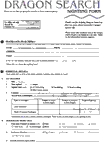 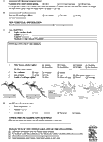
Dragon Search Seadragon Sighting Form
that is used to report seadragon sightings.
Back to contents
What are we
doing
Dragon Search no longer has part time
coordinators in each Australian State where seadragons
are known to occur. However, the data submitted will
be pooled and can be periodically assessed to expand
the existing reports.
In South Australia, the Reef Watch Feral or In Peril
program continues to provide education about seadragons.
Back to contents
What are the
principal aims of Dragon Search?
1. To increase awareness, understanding
and appreciation of syngnathid fish and the need for
their protection and conservation.
2. To actively promote habitat protection
and species conservation through the abatement of threats
affecting the marine environment and syngnathid fish.
3. To establish a pilot program of community-based
monitoring and a database that can be used as an aid
to increase knowledge and define key habitat areas for
syngnathids.
4. To instil community pride and custodianships
for our unique marine environment and wildlife.
Back to contents
That face looks
familiar
A research team from Griffith University
has been using photographs to identify the facial patterns
of individual Leafy Seadragons and sonic tagging techniques
to learn more about their ecology and territorial behaviour.
If you would like to contribute, the photographs need
to be high quality, and show well-lit, close-ups of
the face. You may like to photograph or video seadragons
at the sites you dive regularly, to try and identify
individuals. Observations of activity at night are also
valuable.
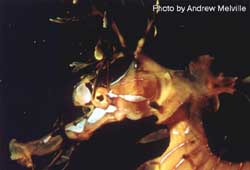
Individual leafy seadragons can be identified
by their distinctive facial markings. Photo by Andrew
Melville.
Back to contents
The database
Information from the sighting sheets
is automatically stored in a database. Our database
containing the raw data is confidential and NO site
specific information is passed on. Analysis of the Dragon
Search databases from each State will be released as
they are produced. These reports will based on Australia's
marine bioregions. Dragon Search has actively encouraged
syngnathid protection legislation nationally and at
a state level. With the on-going success of this community-based
survey program we hope to encourage the development
of databases for other endemic and protected fish and
invertebrate species.
Dragon Search promotes the need for marine
reserves, not just for seadragons, but to conserve a
comprehensive and representative range of our unique
marine life and habitats. No-take marine reserves provide
refuges for fish and therefore provide benefits to the
local marine environment and in the long term the fishing
industry. Dragon Search also supports the principles
of Ecologically Sustainable Development.
Back to contents
I don't
dive or snorkel, but want to help...
Seadragons can be found on the beach
because they have bony-plates which help preserve their
bodies after death. Beachcombers' reports of beach-washed
seadragons can give us valuable information from areas
that may be unsuitable for diving, following storms
or in the colder months when diving activities generally
decrease. Historical records and fishermen's and field
naturalists’ observations are also useful.
Back to contents
References
Connolly, R. (1998).
Measuring the home range of leafy seadragons. The
Dragon's Lair Vol. 3 No. 2 : p3.
Gomon, M.F., Glover,
J.C.M. & Kuiter, R.H. (eds.) (1994). 'The Fishes
of Australia's South Coast'. (State Print : Adelaide).
Groves, P. (1998).
Leafy seadragons. Scientific American December
1998 : 54-59.
Jones, G.P. &
Kaly, U.L. (1995). Conservation of rare, threatened
and endemic marine species in Australia, State of
the Marine Environment Report, Technical Annex:1,
The Marine Environment, Ocean Rescue, DEST, pp 183-191.
Noss, R.F. (1990).
Indicators for measuring biodiversity: hierarchical
approach. Conservation Biology 4 : 355-364.
Back to contents
© Copyright Dragon Search 2000
TOP
|





